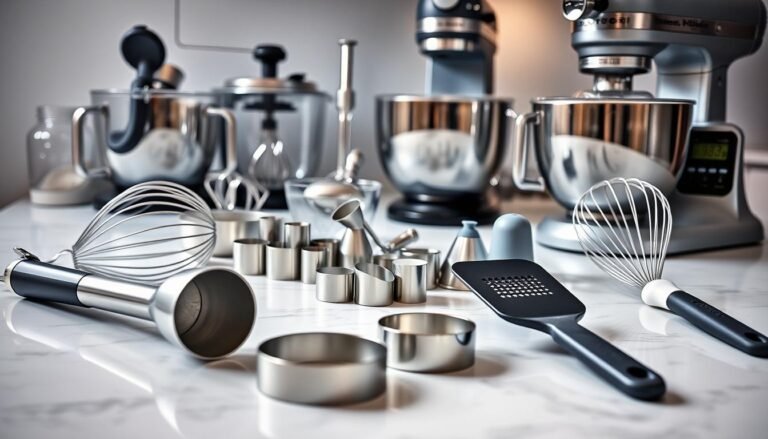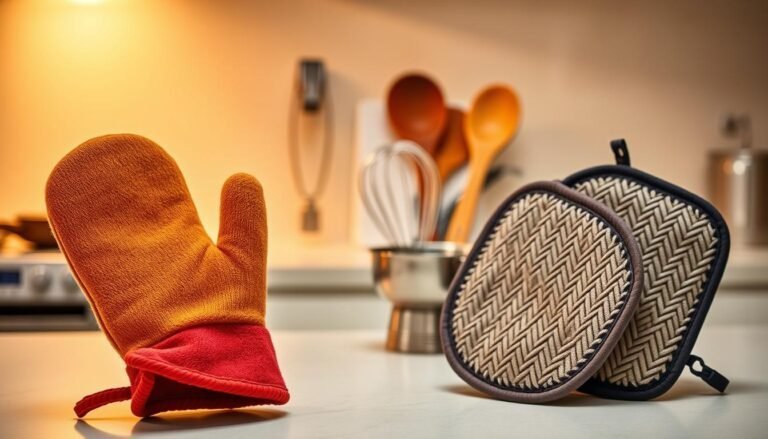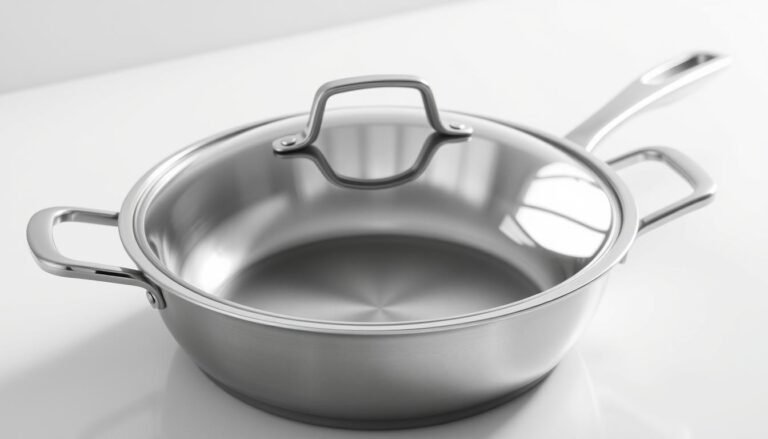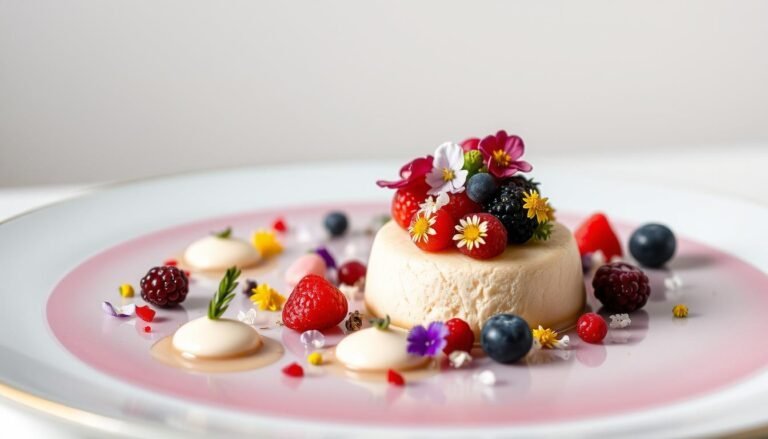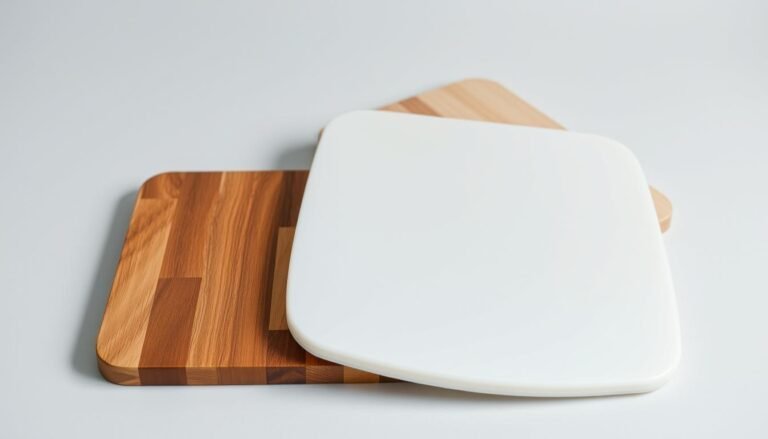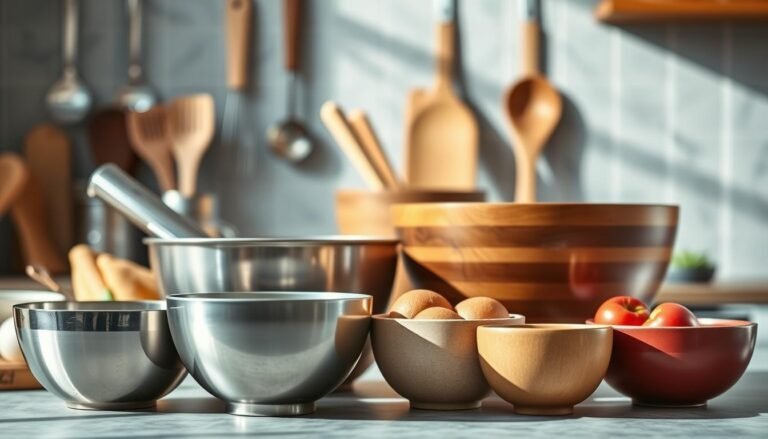Disclosure: This Post Contains Affiliate Links; We earn a commission on purchases.
Having the right tools in the kitchen is key. A kitchen spatula is very useful and used a lot.
Choosing between a rubber and silicone spatula can be tricky. Both have good points and not-so-good points.
The right cooking utensil can really change how you cook. We’ll look at the differences between rubber and silicone spatulas. This will help you pick the best one for your kitchen.
Key Takeaways
- Understand the benefits and drawbacks of rubber spatulas.
- Learn about the advantages and disadvantages of silicone spatulas.
- Discover which type of spatula is best suited for your cooking needs.
- Find out how to choose the right spatula for your kitchen tasks.
- Get tips on maintaining and caring for your spatula.
Understanding Kitchen Spatulas: The Basics
Learning about kitchen spatulas can make cooking better. A kitchen spatula is not just a simple tool. It’s a key culinary accessory that has changed a lot over time.
What Makes a Good Kitchen Spatula
A good kitchen spatula is durable, flexible, and can handle heat. The material, like rubber or silicone, is very important. It should have:
- Flexibility to scrape the sides of bowls
- Heat resistance for high-temperature cooking
- Non-stick properties to prevent food from sticking
The Evolution of Kitchen Spatulas
Kitchen spatulas have changed a lot from old metal or wooden ones. Now, they’re made from rubber and silicone. This makes them better at handling heat and more flexible.
Why Spatulas Are Essential Culinary Accessories
Culinary experts say the right kitchen tools are key for cooking and serving. Spatulas are among the top 5 must-haves. They’re used for many things, like flipping food and mixing ingredients.
What Are Rubber Spatulas?
Rubber spatulas are a must-have in the kitchen. They help with tasks like scraping bowls and mixing ingredients. They are soft and won’t hurt your food.
Composition and Manufacturing Process
Rubber spatulas are made from rubber or synthetic materials. They are molded into shape, often with a handle. This makes them a versatile spatula for many kitchen jobs.
Common Uses in the Kitchen
They are great for mixing, folding, and scraping containers. Their non-stick surface is perfect for sticky foods like honey.
Advantages as a Versatile Spatula
Rubber spatulas are gentle on cookware. They won’t scratch non-stick surfaces. They’re also easy to clean and safe for food.
Limitations and Drawbacks
But, rubber spatulas have some downsides. They can’t handle high heat and might melt or change shape. So, they’re not good for hot dishes on the stovetop.
What Are Silicone Spatulas?
Silicone spatulas are special cooking tools. They are heat-resistant. This makes them a top choice for many cooks.
Composition and Manufacturing Process
Silicone spatulas are made from a flexible, rubber-like material. They can handle high temperatures. The making process shapes the silicone into a spatula form, often with a handle that doesn’t get hot.
![]()
Heat-Resistant Properties
Silicone spatulas can handle very hot temperatures. They won’t melt or bend. This is great for frying, sautéing, and baking. Serious Eats says they are essential in any kitchen.
Versatility as a Cooking Utensil
Silicone spatulas are great for many tasks. They’re good for mixing and scraping bowls. Their flexibility is perfect for careful work.
Potential Disadvantages
Even with their benefits, silicone spatulas can stain. This happens when used with some foods. Cleaning them often keeps them looking new.
Rubber or Silicone Spatula: Key Differences
Choosing between rubber and silicone spatulas is important. Each has its own strengths for different kitchen tasks.
Heat Resistance Comparison
Silicone spatulas can handle much higher temperatures than rubber ones. Rubber spatulas can go up to 350°F (175°C). But, silicone spatulas can go over 500°F (260°C).
Durability and Longevity
Silicone spatulas last longer than rubber ones. They don’t crack as easily. But, the material and how it’s made also matter.
Flexibility and Stiffness
Rubber spatulas are great for scraping bowls and mixing. They’re very flexible. Silicone spatulas are a bit stiffer. This is good for thick batters or dough.
Odor and Stain Resistance
Silicone spatulas are better at not holding onto smells or stains. They’re non-porous. This makes them easy to keep clean.
Price and Value Comparison
Rubber spatulas are cheaper than silicone ones. But, silicone spatulas are more durable and heat-resistant. They might be a better value over time, even if they cost more at first.
Performance in Different Cooking Scenarios
Rubber and silicone spatulas work differently in various cooking tasks. Knowing how they perform is key to picking the right one.
Baking Applications
In baking, a spatula needs to be flexible and non-stick. Silicone spatulas are great for gently mixing ingredients. They’re also easy to clean and don’t stain.
Stovetop Cooking
Heat resistance is important on the stovetop. Silicone spatulas handle high heat well. They’re perfect for scraping pans and flipping food.
Non-Stick Cookware Compatibility
Using non-stick cookware means avoiding damage to the coating. Both rubber and silicone spatulas are safe. But soft silicone spatulas are extra gentle.
Mixing and Folding Techniques
For mixing and folding, a spatula’s flexibility matters. Rubber spatulas are good for these tasks. They mix well without scratching bowls.
High-Temperature Applications
Silicone spatulas are better for high heat. They don’t melt or change shape, even in extreme heat. This makes them great for grilling or broiling.
In summary, choosing between rubber and silicone spatulas depends on the cooking task. Understanding their strengths in different situations helps cooks make the best choice.
Maintenance and Care
To keep your rubber or silicone spatula in top shape, regular care is key. Proper maintenance extends its life and keeps it reliable in the kitchen.
Cleaning and Sanitization Methods
Cleaning your spatula often is vital for cleanliness. For rubber and silicone spatulas, warm, soapy water works well. You can also sanitize them in a water and white vinegar mix. Avoid using harsh cleaners or scouring pads to prevent damage.
Preventing Damage and Extending Lifespan
To make your spatula last longer, don’t expose it to extreme heat suddenly. Silicone spatulas can handle heat, but slow changes are best. Check your spatula often for wear signs.
Storage Recommendations
Keep your spatulas dry and in a safe spot. You can hang them or put them in a holder. Don’t store them in a crowded drawer to avoid damage.
Signs It’s Time to Replace Your Spatula
- Cracks or breaks in the material
- Significant discoloration
- A persistent bad smell despite regular cleaning
- Warping or bending that affects performance
Replacing your spatula when needed keeps it effective and safe for cooking.
Making the Right Choice for Your Kitchen Needs
Whether you cook a lot or just sometimes, the right spatula matters. You should pick between rubber and silicone spatulas based on how you cook.
For the Casual Home Cook
If you cook now and then, a rubber spatula works for simple tasks. But, if you cook at very high temperatures often, a silicone spatula is better. It lasts longer and handles heat well.
For the Avid Baker
Bakers who cook a lot will like silicone spatulas. They are great for mixing and can handle oven heat.
For Professional Kitchens
In busy kitchens, spatulas need to be tough and handle heat well. Silicone spatulas are best because they last longer and can take high temperatures.
Environmental and Sustainability Considerations
Thinking about the planet? Look at the spatula’s material. Some rubber spatulas are eco-friendly because they’re made from natural rubber. But, silicone spatulas might be more sustainable because they last longer.
Best of Both Worlds: Hybrid Options
Some brands make spatulas that mix rubber and silicone. These spatulas offer rubber’s flexibility and silicone’s heat resistance. They’re good for many kitchen tasks.
Conclusion: The Verdict on Rubber vs. Silicone Spatulas
Choosing the right kitchen spatula is key for all cooks. The debate between rubber and silicone spatulas depends on your cooking style. Think about heat resistance, durability, and flexibility when picking.
Rubber spatulas are great for gentle scraping and folding. Silicone spatulas are better for high-heat cooking. Knowing what each material does best helps you choose wisely.
Having the right tools, like a good spatula, makes cooking better. Think about your cooking habits and the qualities of rubber and silicone spatulas. This way, you’ll pick the best for your kitchen.
FAQ
What is the main difference between rubber and silicone spatulas?
Can I use a rubber spatula for high-temperature cooking?
Are silicone spatulas non-stick?
How do I clean and sanitize my rubber or silicone spatula?
Can I use a silicone spatula for mixing and folding delicate ingredients?
Are rubber spatulas useful in the kitchen?
How do I store my rubber or silicone spatula to extend its lifespan?
What are the environmental implications of choosing between rubber and silicone spatulas?
Can I use a rubber or silicone spatula with non-stick cookware?
How often should I replace my rubber or silicone spatula?

From beginner-friendly tips to no-fuss dessert ideas, Ryan is all about helping people enjoy baking and treat-making without the stress. Whether you’re whipping up something for a party or just craving something sweet, Ryan’s practical approach makes it easy to create desserts that taste great and don’t take all day.
Subscribe to Our Newsletter

